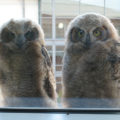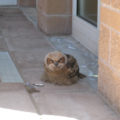We’re having a big snowstorm in Colorado today, so I have been discussing with some local colleagues on Twitter how to measure accumulations. I haven’t lived around snow much (til I moved to Colorado last year), so I haven’t done this much before.
@vdotw advised “Measure [with a ruler] at a flat spot, like an outside table.”
Well, okay, we have lots of outside tables at Sun’s Broomfield campus, but they all seem to have accumulated different amounts of snow:
This one (shown at far left in the photo above) had about 5 inches:
This one looked more promising:
And, in fact:
Thirteen inches! (That’s a fourteen-inch ruler.)
So what am I supposed to do here? Take an average?









In general yes … take an average. When looking to measure snow pay attention to things around your measuring site that might affect how much snow is on the ground. For example trees, shrubs and buildings that can impede snowfall. Consider if the wind is blowing west (snow falling east to west) then a building just east of your measuring site might be blocking some of the snow.
Also avoid obvious sites of drifted snow which have higher accumulations than surrounding areas. In a building area winds can blow snow off roofs and load nearby sites, and of course snow will form drifts up against the windward side of buildings or fences or shrub lines.
Note also that clearing an area between measurements will lead to a final total that is much higher than if you just allow the snow in a major storm to accumulate all day. This is because snow compacts the deeper it gets. So for example in a major storm if I leave it all day I might measure 2 feet. If my neighbor clears it off every time he gets 6 inches, his final total might push 3 feet. That’s a big difference!
But its the real world measurements that count – i.e. what actually is on the ground at the end of the storm so in that case my measurement is more “natural”. Hope that helps! From one Coloradoan to another … peace!
Snow Measurement Guidelines
for
National Weather Service
Snow Spotters:
Place your snowboard outside. A snowboard can be any lightly colored board that is about 2 feet by 2 feet. A piece of plywood painted white works very well. Choose a location that is away from trees, buildings, and shadows. Try to avoid areas that are known to be prone to drifting. Mark the location of the snowboard with a stake so you can find it after a fresh snowfall.
Snowfall is measured to the nearest tenth of an inch. Measure the greatest amount of snowfall that has accumulated on your snowboard since the last observation. You can measure on a wooden deck or ground if a snowboard is not available. Snowfall should not be measured more than 4 times in 24 hours. You can measure the hourly snowfall rate, but do not clean off your board each hour. Only clean off the board when you take one of the four daily measurements. Once the snow ends, add up the measurements from each time the snowboard was cleaned to reach a storm total.
Special cases:
– Snow falls and accumulates on the snowboard, but then melts. In this case, the snowfall is the greatest depth of snow observed on the board before it begins to melt. If this occurs several times, measure the snowfall after each snow shower and add each measurement for the total snowfall.
– Snow falls and melts continuously on the board. In this case, if the snow never reaches a depth of a tenth of an inch, then a trace of snowfall is recorded.
– Snow has blown or drifted onto the snowboard. In this case, take several measurements from around the yard where the snow has not drifted, being careful only to measure new snow. Take an average of the various measurements to arrive at a total.
– Sleet counts towards total snowfall, freezing rain accumulation does not.
Measuring Snow Depth
The depth of snow on the ground includes both new snow and old snow which was in place. Measure the total snow depth at several locations in your yard which have not drifted or blown. Take an average of these measurements to arrive at the snow depth. Sometimes old snow can be very hard and crusty underneath the new snow. Be sure that the ruler gets all the way down to the underlying ground. Snow depth is measured to the nearest inch.